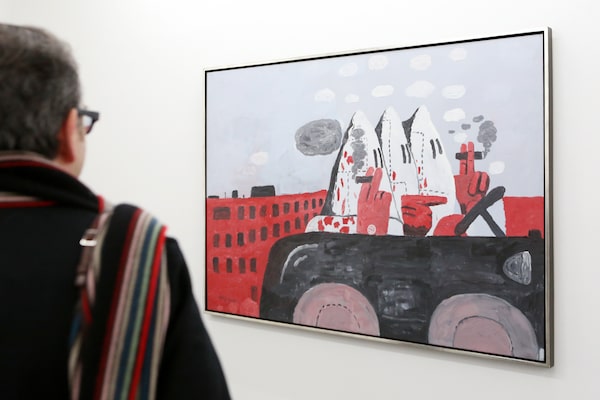
A visitor looks at the work 'Riding Around' by Philip Guston (1913-1980) in the exhibition rooms of the collection Falkenberg in Hamburg, Germany, on Feb. 21, 2014.picture alliance/AFP/Getty Images
Late in his career, the abstract expressionist painter Philip Guston returned to representational styles and executed a series of paintings in which hooded figures, like cartoon Klansmen, are shown smoking, talking or driving in a car. It’s those unsettling images that are at the heart of a controversy that erupted last month after four museums decided to postpone a Guston retrospective set to open next year. Art critics, scholars and artists have denounced the decision. Last week 100 professionals signed an open letter saying the museums have a responsibility to show the complex work and shouldn’t fear controversy.
It’s a debate that pits a pure position against a practical one. Obviously, Guston’s images are not a celebration of the Klan and, yes, museums should be able to show those paintings with enough context to make that clear. In an ideal world that would have been happening next June as the National Gallery of Art in Washington unveiled the show, which was also set to visit the Tate Modern in London and fine arts museums in Boston and Houston. However, the difficulty, in a moment riven by divisive debates over race and violence in both the United States and the United Kingdom, is what might happen outside the museum, where nuance might be lost in outrage and protests that could overwhelm the show.
The museums did not initially explain in great detail why they are postponing the retrospective, only saying in their statement that it was because of the racial justice movement that began in the U.S. As the controversy has built, the Tate has come forward to add that it was respecting the position of U.S. colleagues who did not feel they could proceed with the exhibition as long as the only curators involved were white.
The 24 Klan paintings, although not directly cited, represent the obvious stumbling block. They were born of Guston’s lifelong awareness of prejudice, including the anti-Semitism both he and his parents had experienced, and have been said to be initially inspired by an incident in which vandals defaced an anti-racist mural he had painted during his early years in Los Angeles.
Guston was born Phillip Goldstein in Montreal in 1913. His parents were Ukrainian Jews who immigrated to Canada at the beginning of the 20th century and then moved to L.A. while Guston was a young boy. Although he was always interested in cartooning and began his career as a representational mural painter in the 1930s, he went on to become a leading figure in the abstract expressionist movement after he moved to New York and anglicized his surname. When he rejected abstraction and unveiled raw new figurative work in 1970, modernist critics were appalled.
That work, which includes images of human figures, heads, buildings and everyday objects, often executed in pinks and pale reds, could be openly mocking: Guston once portrayed Richard Nixon with a phallic nose and scrotum-like jowls. The Klan paintings, however, represent a more complex and ambivalent satire. The hooded figures look bumbling, more ridiculous than terrifying, but mainly Guston made them look mundane. The artist, who died in 1980 at age 66, said he was fascinated by the idea of evil and imagined himself inside the hood. The paintings suggest the ubiquity of racism in American society, and don’t let the painter or the viewer off the hook.
That makes them highly topical but also paradoxically hard to exhibit. Critics have complained the museums are being patronizing when they say they need time to provide more context for the work, as though viewers couldn’t be trusted to understand satire. But maybe it’s not viewers the museums are worried about; it’s people who haven’t been to the show spreading word on social media that the National Gallery is exhibiting a bunch of pink cartoons of the KKK. Take a look what happened this summer when people who had never seen the coming-of-age Netflix film Cuties decided to judge it based solely on one publicity still. Righteous indignation rapidly overtook informed criticism. Similarly, critics of Dana Schutz’s painting of lynching victim Emmett Till, shown at the Whitney Biennial in 2017, had little time for the larger context of the white artist’s practice.
Satire can be a particularly hard sell in the solemn space of an art museum. Its bitter accusations are often defanged by the genteel setting, or it can be completely misunderstood. The most famous Canadian case of a protest against a museum remains the controversy over the 1989 show Into the Heart of Africa at the Royal Ontario Museum. The exhibition intended to mock the attitudes of the 19th- and early 20th-century white missionaries that it depicted but its critics, many of whom never saw the show, condemned it as racist. Four years ago the ROM, which now would never plan such an exhibit without consulting the community, apologized.
With these kind of difficult examples at hand, is it any wonder the museums want to take the Guston retrospective slowly? They may not have done the right thing, but they have done the sensible thing.
Find out what’s new on Canadian stages from Globe theatre critic J. Kelly Nestruck in the weekly Nestruck on Theatre newsletter. Sign up today.
 Kate Taylor
Kate Taylor